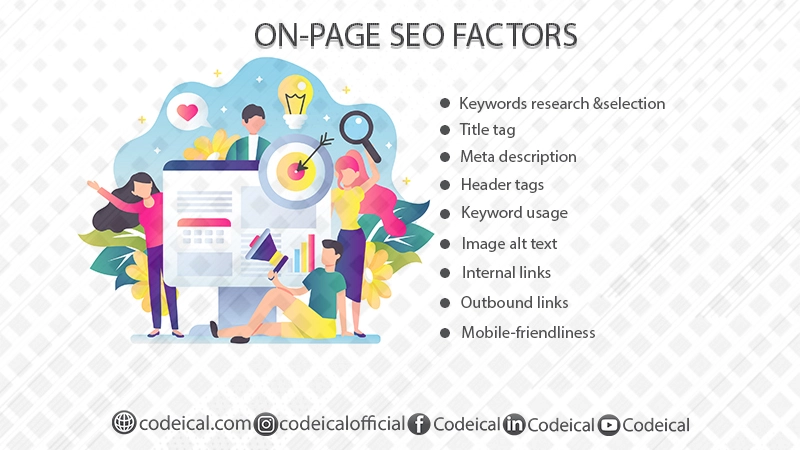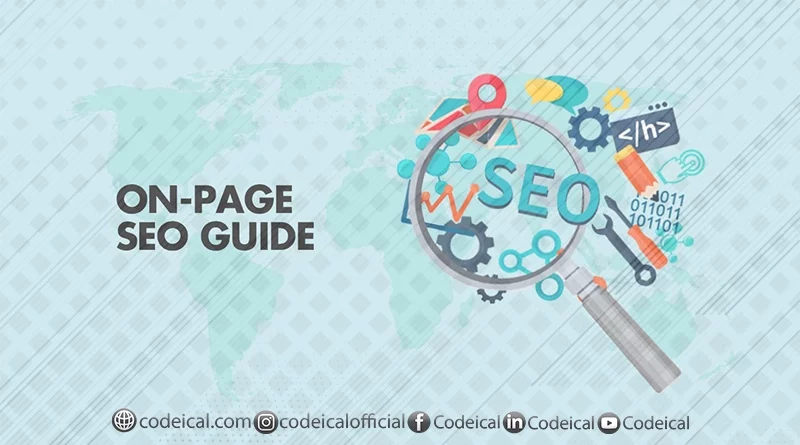What is On-Page SEO & 7 ways to do On-Page SEO & boost your page like never before
Introduction
On-page SEO involves the strategic optimization of both the content and underlying code of a webpage to enhance its position within the search engine results pages (SERPs). This vital component constitutes one of the fundamental pillars of search engine optimization (SEO), working in conjunction with off-page SEO to maximize visibility and organic traffic for a website. If you want to learn more about SEO CLICK HERE & If you want to get a free SEO course CLICK HERE
On-Page SEO Factors
On-page SEO factors encompass a range of elements that contribute to optimizing web pages for search engines. These factors are crucial for enhancing the visibility and relevance of your website’s content. Here are some key aspects to consider:
- Keyword research and selection: To effectively optimize your web pages, it is essential to conduct comprehensive keyword research. This involves identifying the specific terms and phrases that your target audience uses when searching for information online. Once you have compiled a list of relevant keywords, you need to carefully select those that are most appropriate for your website and have a higher probability of achieving favorable rankings.
- Title tag optimization: The title tag holds immense significance in on-page SEO. It is the text that appears at the top of a web browser tab and in search engine results pages. Crafting an optimized title tag involves incorporating your target keyword or keywords and ensuring that it is concise, clear, and directly relevant to the content of the respective page.
- Meta description enhancement: The meta description is a brief text that appears beneath the title tag on search engine results pages. It serves as a concise summary of the page’s content. Optimizing the meta description involves incorporating your target keyword or keywords and providing users with a succinct overview of the page’s content.
- Effective utilization of header tags: Header tags (H1, H2, H3, and so on) are crucial for organizing the content on a web page. These tags should be strategically utilized to emphasize the most vital information on the page while also incorporating your target keyword or keywords.
- Thoughtful keyword incorporation: It is important to incorporate your target keyword or keywords throughout the content of your web page. However, it is crucial to do so naturally, avoiding any spammy or excessive usage of the keyword. The goal is to maintain a balanced and meaningful integration of keywords into the content.
- Descriptive image alt text: Image alt text refers to the text displayed when an image fails to load. Optimizing alt text involves incorporating your target keyword or keywords and providing a descriptive explanation of the image.
- Effective use of internal links: Internal links are links that connect different pages within your website. They aid in website navigation for users and facilitate the crawling and indexing process for search engines like Google. Implementing internal links strategically can contribute to improving your website’s rankings in search engine results pages.
- Relevance of outbound links: Outbound links are links from your website to other external websites. When including outbound links, it is important to ensure they are of high quality and relevance to the content. Appropriate usage of outbound links can positively impact your website’s rankings in search engine results pages.
- Mobile-friendly design: In recent times, Google prioritizes websites that are mobile-friendly. This necessitates designing your website to ensure proper display and functionality on smartphones and tablets. A mobile-friendly website is more likely to achieve better rankings in search engine results pages.
By considering and implementing these on-page SEO factors, you can enhance the visibility, relevance, and overall optimization of your website’s content for search engines.

On-page SEO factors encompass a range of elements that contribute to optimizing your website for search engines. Alongside these on-page SEO factors, there are numerous additional strategies you can implement to enhance your website’s position within search engine results pages. These strategies encompass:
- Content optimization: Ensuring your website features top-notch, informative content that is highly relevant to your intended audience.
- Technical SEO: Guarantee that your website is well-coded and devoid of any errors or glitches.
- Social media marketing: Engaging in promotional activities on various social media platforms to enhance your website’s visibility and boost its ranking in search engine results pages.
- Link building: Engaging in the practice of acquiring links from external websites that point to your website. This method aids in elevating your website’s ranking within search engine results pages.
Tips for doing On-Page SEO
On-page SEO factors encompass a crucial aspect of any comprehensive SEO strategy. By meticulously enhancing the content and code of your website, you can elevate its position in search engine results pages and effectively draw a larger influx of visitors to your online domain.
Here are several additional recommendations for implementing on-page SEO techniques:
• Utilize a highly efficient and advanced keyword research tool to effectively pinpoint and discover the most suitable and optimal keywords that perfectly align with your website’s content and objectives.
• Make sure to incorporate your desired keywords into various elements of your website, such as the title tag, meta description, header tags, and the overall content presented on your web pages.
• To enhance the visual appeal of your website, consider incorporating images and videos to intersperse within your textual content.
• Enhance the performance of your website by optimizing its layout, design, and functionality to cater specifically to the needs and requirements of mobile devices, ensuring a seamless user experience regardless of the screen size or device type.
• Keep your site up-to-date with fresh new content. Ensure that your website remains constantly updated by regularly adding new and relevant content to it.
• Utilize various social media platforms to effectively promote and raise awareness about your website, enhancing its online presence and increasing its visibility to a wider audience.
• Establish a network of valuable connections by securing backlinks to your website from authoritative and reputable websites within your industry.
By adhering to the suggestions provided above, you have the opportunity to enhance your website’s positioning within the search engine results pages, ultimately drawing a larger audience to your online platform.
If you want to learn about SEO-Search Engine Optimization in detail & about off-page and technical SEO CLICK HERE
If you want a paid SEO course CLICK HERE

